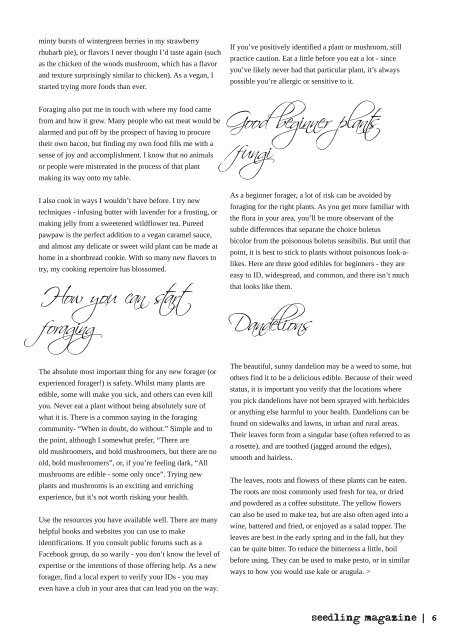Seedling Magazine
Seedling is a new digital magazine aimed at making the world a better place. Read about sustainability, spirituality, nature, personal growth and more - all from a vegan perspective!
Seedling is a new digital magazine aimed at making the world a better place. Read about sustainability, spirituality, nature, personal growth and more - all from a vegan perspective!
Create successful ePaper yourself
Turn your PDF publications into a flip-book with our unique Google optimized e-Paper software.
minty bursts of wintergreen berries in my strawberry<br />
rhubarb pie), or flavors I never thought I’d taste again (such<br />
as the chicken of the woods mushroom, which has a flavor<br />
and texture surprisingly similar to chicken). As a vegan, I<br />
started trying more foods than ever.<br />
Foraging also put me in touch with where my food came<br />
from and how it grew. Many people who eat meat would be<br />
alarmed and put off by the prospect of having to procure<br />
their own bacon, but finding my own food fills me with a<br />
sense of joy and accomplishment. I know that no animals<br />
or people were mistreated in the process of that plant<br />
making its way onto my table.<br />
I also cook in ways I wouldn’t have before. I try new<br />
techniques infusing butter with lavender for a frosting, or<br />
making jelly from a sweetened wildflower tea. Pureed<br />
pawpaw is the perfect addition to a vegan caramel sauce,<br />
and almost any delicate or sweet wild plant can be made at<br />
home in a shortbread cookie. With so many new flavors to<br />
try, my cooking repertoire has blossomed.<br />
How you can start<br />
foraging<br />
If you’ve positively identified a plant or mushroom, still<br />
practice caution. Eat a little before you eat a lot since<br />
you’ve likely never had that particular plant, it’s always<br />
possible you’re allergic or sensitive to it.<br />
Good beginner plants<br />
/fungi<br />
As a beginner forager, a lot of risk can be avoided by<br />
foraging for the right plants. As you get more familiar with<br />
the flora in your area, you’ll be more observant of the<br />
subtle differences that separate the choice boletus<br />
bicolor from the poisonous boletus sensibilis. But until that<br />
point, it is best to stick to plants without poisonous lookalikes.<br />
Here are three good edibles for beginners they are<br />
easy to ID, widespread, and common, and there isn’t much<br />
that looks like them.<br />
Dandelions<br />
The absolute most important thing for any new forager (or<br />
experienced forager!) is safety. Whilst many plants are<br />
edible, some will make you sick, and others can even kill<br />
you. Never eat a plant without being absolutely sure of<br />
what it is. There is a common saying in the foraging<br />
community “When in doubt, do without.” Simple and to<br />
the point, although I somewhat prefer, “There are<br />
old mushroomers, and bold mushroomers, but there are no<br />
old, bold mushroomers”, or, if you’re feeling dark, “All<br />
mushrooms are edible some only once”. Trying new<br />
plants and mushrooms is an exciting and enriching<br />
experience, but it’s not worth risking your health.<br />
Use the resources you have available well. There are many<br />
helpful books and websites you can use to make<br />
identifications. If you consult public forums such as a<br />
Facebook group, do so warily you don’t know the level of<br />
expertise or the intentions of those offering help. As a new<br />
forager, find a local expert to verify your IDs you may<br />
even have a club in your area that can lead you on the way.<br />
The beautiful, sunny dandelion may be a weed to some, but<br />
others find it to be a delicious edible. Because of their weed<br />
status, it is important you verify that the locations where<br />
you pick dandelions have not been sprayed with herbicides<br />
or anything else harmful to your health. Dandelions can be<br />
found on sidewalks and lawns, in urban and rural areas.<br />
Their leaves form from a singular base (often referred to as<br />
a rosette), and are toothed (jagged around the edges),<br />
smooth and hairless.<br />
The leaves, roots and flowers of these plants can be eaten.<br />
The roots are most commonly used fresh for tea, or dried<br />
and powdered as a coffee substitute. The yellow flowers<br />
can also be used to make tea, but are also often aged into a<br />
wine, battered and fried, or enjoyed as a salad topper. The<br />
leaves are best in the early spring and in the fall, but they<br />
can be quite bitter. To reduce the bitterness a little, boil<br />
before using. They can be used to make pesto, or in similar<br />
ways to how you would use kale or arugula. ><br />
seedling magazine | 6





